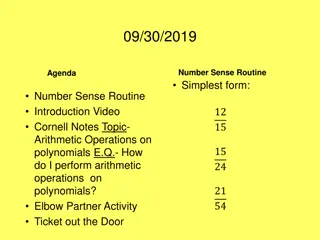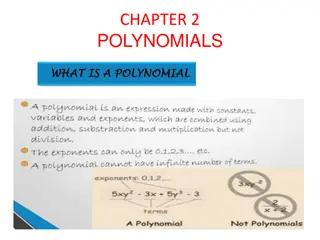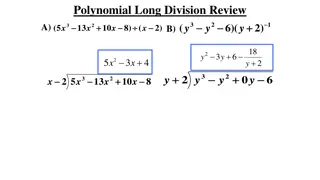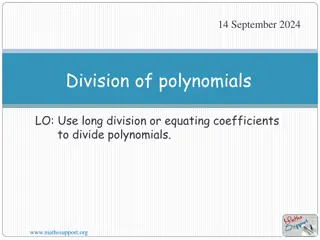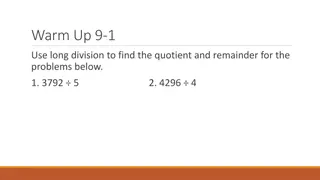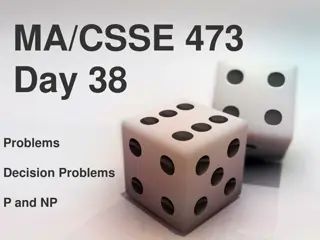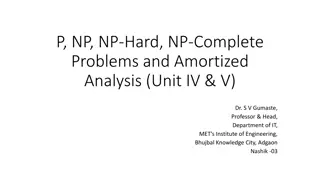Understanding Polynomial Identity Testing in Algorithm Design
Explore the concept of polynomial identity testing as a powerful tool in algorithm design. Learn how to determine if a polynomial is identically zero by choosing random points and applying the Schwartz-Zippel Lemma. Discover the application of this technique in finding perfect matchings in bipartite graphs.
Download Presentation

Please find below an Image/Link to download the presentation.
The content on the website is provided AS IS for your information and personal use only. It may not be sold, licensed, or shared on other websites without obtaining consent from the author. Download presentation by click this link. If you encounter any issues during the download, it is possible that the publisher has removed the file from their server.
E N D
Presentation Transcript
CMPT 405 Design & Analysis of Algorithms January 24, 2022
Plan for today Polynomial identity testing An application: Finding a perfect matching in bipartite graphs
Polynomial Identity Testing
Polynomial Identity Testing Easy Fact: Let p:F F be a non-zero polynomial of degree at most d. Then, p has at most d zeros. For example: p(x) = x3+ 4x+1 has at most 3 zeros. Examples: p(x,y) = x4 + y2 + 4xy2 has degree 4 q(x,y,z) = x2y + x2yz3 + 7y2 - 4x2z2 has degree 6 r(x,y,z) = x + y + xy + xz has degree 2 Stated differently: For any set S F if we choose x S uniformly, then Pr[p(x) = 0] d/|S| We also have an analogous multivariate version of this fact. Schwartz-Zippel Lemma: Let p(x1,x2, xn) be a non-zero polynomial of total degree at most d. Let S F be a subset of the field F. If we choose x1,x2, xn S uniformly, independently, then Pr[p(x1,x2, xn) = 0] d/|S|
Polynomial Identity Testing Schwartz-Zippel Lemma: Let p(x1,x2, xn) be a non-zero polynomial of total degree at most d. Let S F be a subset of the field F. If we choose x1,x2, xn S uniformly, independently, then Pr[p(x1,x2, xn) = 0] d/|S| This looks very useful If we can phrase a problem as a checking if a polynomial is identically zero, then we can check it by choosing a large enough S, and checking p(x) at a random point x Sn. If p is not identically zero, then it is very unlikely that p(x) will be zero. Specifically, Pr[p(x1,x2, xn) 0] 1 - d/|S|
Polynomial Identity Testing Schwartz-Zippel Lemma: Let p(x1,x2, xn) be a non-zero polynomial of total degree at most d. Let S F be a subset of the field F. If we choose x1,x2, xn S uniformly, independently, then Pr[p(x1,x2, xn) = 0] d/|S| Equivalently: Let p(x1,x2, xn) and q(x1,x2, xn) be two distinct polynomials of total degree at most d. Let S F be a subset of the field F. If we choose x1,x2, xn S uniformly, independently, then Pr[p(x1,x2, xn) = q(x1,x2, xn)] d/|S|
Polynomial Identity Testing Schwartz-Zippel Lemma: Let p(x1,x2, xn) be a non-zero polynomial of total degree at most d. Let S F be a subset of the field F. If we choose x1,x2, xn S uniformly, independently, then Pr[p(x1,x2, xn) = 0] < d/|S| Proof: Induction on the number of variables. Base case: n=1 follows from the discussion before. Induction step: Suppose n>1. Let k be the largest power of xn. Then we can write p(x1,x2, xn) =(xn)k q(x1,x2, xn-1)+r(x1,x2, xn).
Polynomial Identity Testing Induction step: Suppose n>1. Let k be the largest power of xn. We can write p ?1,?2, ,?? = ?? ? ? ?1,?2, ,?? 1 + ? ?1,?2, ,?? 1) deg ? ? ?, and hence ?? ? ?1,?2, ,?? 1 = 0 ? ? |?|. 2) If ?1,?2, ,?? 1 ? are such that ? ?1,?2, ,?? 1 0, then ? becomes a non-zero polynomial of degree ? in ??, and hence ? |?|. ?? ? ? = 0|? ?1, ,?? 1 0 Putting it together, we have ?? ? ? = 0 = ?? ? ? = 0|? ?1, ,?? 1 = 0 Pr[? ?1, ,?? 1 = 0] + ?? ? ? = 0|? ?1, ,?? 1 0 Pr ? ?1, ,?? 1 0 1 ? ? ? ? 1 = ? |?|, as required. + ?
Finding a perfect matching in a bipartite graph
Perfect matching in a bipartite graph Input: A bipartite graph G = (U,V,E). Goal: Find a perfect matching in G, or report that there is no perfect matching. T You can solve it using max flow algorithms. S This is done by finding max-flow from S to T.
Perfect matching in a bipartite graph Input: A bipartite graph G = (U,V,E). Goal: Find a perfect matching in G, or report that there is no perfect matching. Today, we ll see a different method that uses the polynomial method
Adjacency matrix of a bipartite graph Given a bipartite graph G = (L, R, E), it is sometimes convenient to thing of its adjacency matrix as follows: The rows correspond to the vertices on the left The columns correspond to the vertices on the right Mu,v = 1 if (u,v) E for u L and v R S T U V W 0 1 1 0 1 A B C D E Mu,v = 0 if (u,v) E 1 0 0 0 0 1 0 0 1 1 A S 0 0 1 0 1 1 0 1 1 0 B T C U D V E W
Determinant of a matrix Recall: Given a nxn matrix A the determinant of A is ??? ? = ???? ? ??,? ? ? ?: ? [?] where ???? ? { 1,1} . Example: 1,2,3 A = [4,5,6] 7,8,9 Det(A) =1*5*9 + 3*4*8 + 2*6*7 3*5*7 1*6*8 2*4*9 Q: Can we compute Det(A) efficiently?
Determinant of a matrix Example: It is easy to compute the determinant for upper triangular matrices 1, 2, 3 A = [0, 3, 6] 0, 0, 7 Det(A) =1*(-3)*7=-21 Q: What about general matrices? Fact: we can use Gaussian elimination to bring A into an upper triangular form A such that det(A) = 0 if and only if det(A ) = 0. Fact2: Gaussian elimination can be performed in O(n3) field operations.
Perfect matching in a bipartite graph Input: A bipartite graph G = (U,V,E) with n vertices on each side. Goal: Find a perfect matching in G, or report that there is no perfect matching. A decision version: Decide whether G contains a perfect matching or not.
Perfect matching in a bipartite graph Q: How can we solve the search version using the decision version? HW2: Prove that if the decision algorithm outputs the correct answer w.h.p., then we can find a PM w.h.p. Suppose we have a decision version outputs the correct answer w.h.p. 1. Run the decision algorithm on G. 2. If G has no perfect matching -> OUTPUT NO PERFECT MATCHING 3. Otherwise, G has a perfect matching. Let s try to find one edge in it: A. Fix a vertex u, and try to find an edge (u,v) E that belongs to the perfect matching. This is done by removing all edges touching u except for one, and running the decision algorithm B. Remove the vertices u and v from G and all edges touching them. C. Find a perfect matching M in G without u and v D. Return M U {(u,v)}
Perfect matching in a bipartite graph Input: A bipartite graph G = (U,V,E) with n vertices on each side. Goal: Decide whether G contains a perfect matching. We take adjacency matrix of G with random values And compute its determinant Algorithm : ??,? ? ?? ?,? ? 1. Define nxn matrix A over formal variables ??,?= ?? ?,? ? 2. For each Xi,jchoose a value in {1, ,T} independently for some large T 3. Compute the determinant of A 4. If det(A) 0 output G contains a perfect matching 5. Else, output No perfect matching found What s going on here???
Perfect matching in a bipartite graph Analysis: Recall: Given a nxn matrix A the determinant of A is ??? ? = ???? ? ??,? ? ? ?: ? [?] Where sign() is some function that outputs either 1 or -1. Observation: There is a one-to-one correspondence between perfect matchings in G and the terms in the sum. Specifically, every perfect matching (1, (1)), (2, (2)) corresponds to the product ???,? ? Thus: G has a perfect matching if and only if det(A) is a non-zero polynomial
Perfect matching in a bipartite graph ??,? ? ?? ?,? ? We define nxn matrix A over formal variables ??,?= ?? ?,? ? G has a perfect matching if and only if det(A) is a non-zero polynomial Case 1: G has a perfect matching, then det(A) is a non-zero polynomial in n2 variables (Xi,j) of degree at most n Therefore, if we choose T large enough, and set the value of each Xi,j randomly from {1, ,T} independently, then Pr[det(A) 0] 1-n/T. Case 2: G has no perfect matching, then det(A) is the all zero polynomial. Therefore Pr[det(A) = 0] = 1
Perfect matching in a bipartite graph Input: A bipartite graph G = (U,V,E) with n vertices on each side. Goal: Decide whether G contains a perfect matching. What is the runtime of this algorithm? Algorithm for the decision version: ??,? ? ?? ?,? ? 1. Define nxn matrix A over formal variables ??,?= ?? ?,? ? 2. For each Xi,jchoose a value in {1, ,T} independently for some large T 3. Compute the determinant of A 4. If det(A) 0 output G contains a perfect matching 5. Else, output No perfect matching found
Finding a minimum weight perfect matching in bipartite graphs
Min-weight perfect matchings Input: A bipartite graph G = (U,V,E) with weights on the edges. Goal: Find a perfect matching in G of minimal weight. We may assume that the graph is a complete bipartite graph, and missing edges have some huge weight.
Min-weight perfect matchings Input: A bipartite graph G = (U,V,E) with |U| = |V| = n and integer weights wi,j>0 Goal (min value version): Output the weight of a min-weight perfect matching. A simplifying (though weird) assumption: Suppose that G has a unique perfect matching of minimal weight. Algorithm for the min value version: What s going on here??? Define nxn matrix A over reals as Ai,j = 10wij 1. 2. Compute the determinant of A 3. Output the largest k such that det(A) is divisible by 10k Example, if det(A) = 41507000, then we output 3 (because 103 divides det(A))
Min-weight perfect matchings Recall: Given a nxn matrix A the determinant of A is ??? ? = ???? ? ??,? ? ? ?: ? [?] Again, we use the one-to-one correspondence between perfect matchings in G and the terms in the sum. Each perfect matching M contributes to the sum ???,? ? = ?10??,? ?= 10 ???,? ?= 10?(?) Therefore , if the min-weight matching in G has weight k and it is unique, then it will contribute 10k, and all others will contribute a multiples of 10*10k. It is easy to find such minimal k (assuming that it is unique).
Min-weight perfect matchings Next time: we ll see how to get rid of the assumption that the min-weight matching is unique. We ll do it by adding to the weight of each edge some O(1/n2) random noise. Since the weight of each matching is a sum of n integers, the weight of the noisy graph will allow us to recover the weight of the original graph. Isolation lemma: we ll see a lemma saying that with high probability we will isolate one min-weight perfect matching. Then we ll apply the algorithm on this graph with noisy weights
Questions? Comments?


